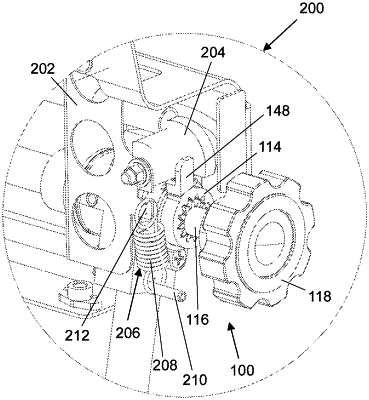| CPC B64D 11/0642 (2014.12) [B64D 11/0689 (2013.01)] | 20 Claims |

|
1. A headrest tilt mechanism, comprising:
a headrest support attachable to a seat assembly component;
a casing fixed to the headrest support, the casing defining an interior annular space and a rotation limiter feature, a first portion of the rotation limiter feature determining a full aft headrest position and a second portion of the rotation limiter feature determining a full forward headrest position;
a driven gear having a portion rotatably disposed in the interior annular space of the casing, the driven gear having an axial opening and a predetermined number of gear teeth formed on an inner circumferential surface thereof;
a driver gear rotatably disposed through the axial opening of the driven gear, the driver gear having a first end interacting with the headrest support and a second end extending outward beyond the casing, and the driver gear having a predetermined number of gear teeth formed on an outer circumferential surface thereof meshed with the predetermined number of gear teeth of the driven gear in a profile shifted configuration;
a tab coupled to the driven gear, the tab interacting with the rotation limiter feature as the driven gear is driven to control a headrest position between the full aft headrest position and the full forward headrest position; and
a knob coupled to the second end of the driver gear for rotating the driver gear to drive the driven gear;
wherein the driven gear has a greater number of gear teeth than the driver gear; and
wherein an axis of the driver gear is shifted relative to an axis of the driven gear by a predetermined distance.
|